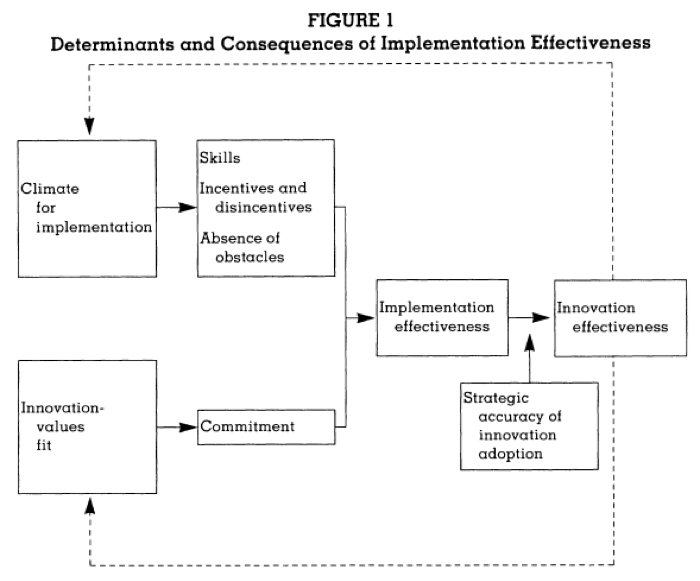Implementation Effectiveness Model
D and/or I:
 The focus on dissemination and/or implementation activities. D-only focuses on an active approach of spreading evidence-based interventions to target audience via determined channels using planned strategies. D=I, D>I, and I>D means there is some focus on both dissemination and implementation. I-only focuses on process of putting to use or integrating evidence-based interventions within a setting.
The focus on dissemination and/or implementation activities. D-only focuses on an active approach of spreading evidence-based interventions to target audience via determined channels using planned strategies. D=I, D>I, and I>D means there is some focus on both dissemination and implementation. I-only focuses on process of putting to use or integrating evidence-based interventions within a setting.
I-Only Socio-Ecological Levels:
 The level of the framework at which the model operates. Individual includes personal characteristics; Organization includes hospitals, service organizations, and factories; Community includes local government and neighborhoods; System includes hospital systems and government; Policy includes changes in policy.
The level of the framework at which the model operates. Individual includes personal characteristics; Organization includes hospitals, service organizations, and factories; Community includes local government and neighborhoods; System includes hospital systems and government; Policy includes changes in policy.
- Individual
- Organization
Number of Times Cited:
 The # of times the original publication for the model was cited as indicated by Google Scholar since 2016.
The # of times the original publication for the model was cited as indicated by Google Scholar since 2016.
159 Field of Origin:
 The field of study in which the model originated.
The field of study in which the model originated.
Management Rating:
 These are ratings given by users of the site.
These are ratings given by users of the site.
Constructs:
 Name of the construct developed by classifying/aligning the elements abstracted from models.
Name of the construct developed by classifying/aligning the elements abstracted from models.
Assessment Instruments:
- AHRQ Digital Health Equity Framework
- CFIR Interview Guide (Lam)
- CFIR Interview Guide (Zhao)
- CFIR Interview Guide Webtool
- Clinical Sustainability Assessment Tool (CSAT)
- Context Matters Reporting Template
- Diagnosis Related Group (DRG) Policy Survey
- Evidence Based Practice Attitude Scale (EBPAS)
- FRAME-IS Adaptation Tracking Instrument
- Glisson's Organizational Social Context (OSC)
- Goodman's Level of Institutionalization
- Hall's Levels of Use Scale
- Implementation Climate Scale (ICS)
- Implementation Leadership Scale (ILS)
- Implementation Strategy Usability Scale
- Intervention Scalability Assessment Tool (ISAT)
- Iterative, Practical, Robust Implementation and Sustainability Model (iPRISM) Webtool
- Landry's Knowledge Utilization Scale among Policymakers
- Local Wellness Policy Implementation Checklist
- Longitudinal Implementation Strategy Tracking System (LISTS)
- Normalization Process Theory Interview Guide
- Normalization Process Theory Questionnaire (NoMAD)
- Organizational Readiness for Implementing Change (ORIC)
- PRISM Contextual Survey Instrument (PCSI)
- PRISM Interview Guide
- Partnership/Synergy Assessment Tool
- Policy Coalition Evaluation Tool (PCET)
- Program Sustainability Assessment Tool (PSAT)
- RAPICE Protocol, Activity, and Interview Prompt Guide
- RAPICE Summary Template
- Readiness Thinking Tool - Observation Guide
- Readiness Thinking Tool - Survey
- Readiness for Recovery and Resiliency - Interview Guide
- Rehabilitation Policy Questionnaire
- Short Program Sustainability Assessment Tool (PSAT)
- Stages of Implementation Completion (SIC)
- Van Schaik's Technology Acceptance Model (TAM)
- i-PARiHS Interview Guide
Citations:
 The original publication(s) of the model.
The original publication(s) of the model.
Klein KJ, Conn AB, Sorra JS. Implementing computerized technology: an organizational analysis. J Appl Psychol 2001;86(5):811.
Klein KJ, Sorra JS. The challenge of innovation implementation. Acad Manag Rev 1996:1055–80. Examples:
 Citations of studies that have used the model as an outline for their study.
Citations of studies that have used the model as an outline for their study.
Dong L, Neufeld DJ, Higgins C. Testing Klein and Sorra’s innovation implementation model: an empirical examination. J Engin Technol Manag 2008;25(4):237-55.Holahan PJ, Aronson ZH, Jurkat MP, Schoorman FD. Implementing computer technology: a multiorganizational test of Klein and Sorra’s model. J Engin Technol Manag 2004;21(1-2):31-50.
Osei-Bryson KM, Dong L, Ngwenyama O. Exploring managerial factors affecting ERP implementation: an investigation of the Klein-Sorra model using regression splines. Inf Syst J 2008;18(5):499-527.
Robertson J, Sorbello T, Unsworth K. Innovation Implementation: the role of technology diffusion agencies. J Technol Manag Innov 2008;3(3):1-10.
Sawang S. Innovation implementation effectiveness: a multiorganizational test of Klein Conn and Sorra’s model. [dissertation]. 2008.
Sheldon MR. Evidence-based practice in occupational health: description and application of an implementation effectiveness model. Work: J Prev Assess Rehab 2007;29(2):137-43.
There are no reviews yet. Be the first one to write one.
